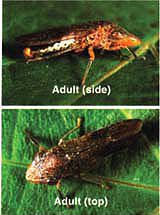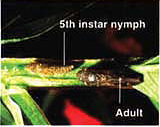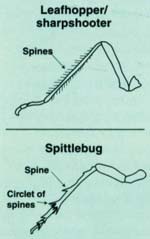All Issues
How to distinguish glassy-winged sharpshooter from its “look-a-likes”
Publication Information
California Agriculture 55(4):12-12.
Published July 01, 2001
PDF | Citation | Permissions
Full text
An intense search is under way in many areas to prevent the introduction of glassy-winged sharpshooter, a nonnative invasive insect linked to the spread of Xyllela fastidiosa, the bacterium that causes Pierce's disease. Since many people have not seen the glassy-winged sharpshooter, it can be confused with other insects occurring in vineyards and backyards (“look-a-likes“). The following photos and descriptions are useful tools in correctly identifying this pest.
Adult glassy-winged sharpshooter
-
Approximately 1/2 inch (11 to 13 mm) long.
-
Dark brown to black in color with an ivory underside.
-
Top of the head has small, ivory-to-yellowish spots.
-
Body shape is parallel-sided with a pointed head.
-
Wings are partly transparent with reddish veins.
-
Wings are folded flat over the body.
-
Length of hind tibia has two rows of small spines (fig. 1).
-
While resting, they shift their bodies from side to side (inspiring the name “sharpshooters”).
Nymphal stages
-
Glassy-winged sharpshooter has five nymphal (immature) stages.
-
Nymphal length ranges from 1/16 inch (2 mm) long for the first stage up to 3/8 inch (9 mm) for fifth stage.
-
Nymphs are olive-gray with prominent reddish eyes.
-
Immatures are wingless and have softer bodies.
-
Immatures have piercing/sucking mouthparts and a bulging face.









